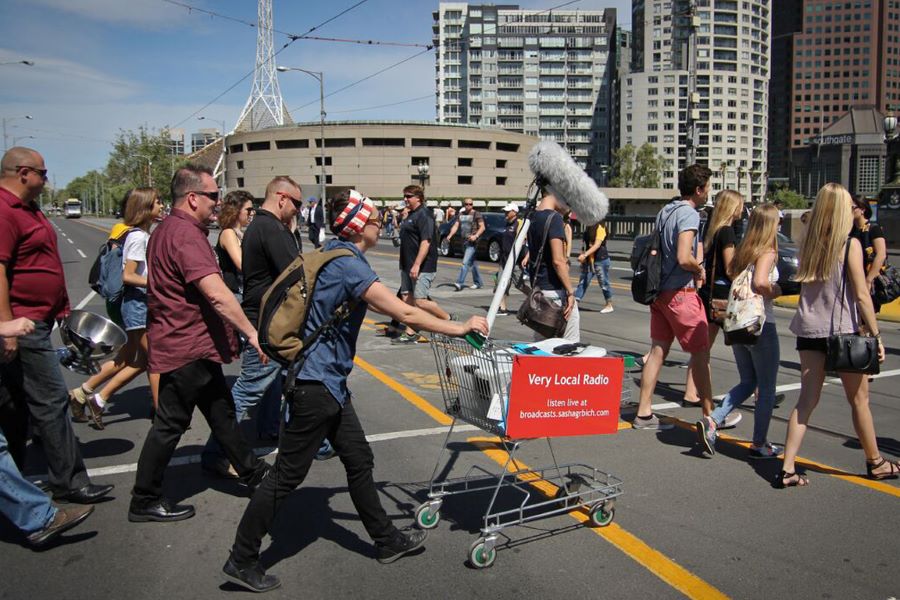Grbich’s works are often iterative; once she has established a process, she revisits that method in new spaces or with different participants.
Image: Sasha GRBICH with Heidi Angove, Very Local Radio, 2014-15, still image from live performance. Photography by Zihan Loo. Image courtesy the artist.
SASHA GRBICH
Sasha Grbich is a good listener. Her socially engaged practice is deeply attuned to the subtle rhythms and background hums of the real world. Through live art actions, relational situations and video documentation, Grbich employs a process of sensitive and attentive listening to open up a space in which difficult or seemingly impossible conversations can occur.
In Very Local Radio (2014, 2015) the artist navigated city streets, pushing a shopping trolley loaded with sound recording gear and an internet radio transmitter. The sensorial focus of her urban exploration was shifted from the ocular to the auditory, seeking out unique ecologies of sound that were then broadcast online. Deprived of visual data, listeners had to assemble an understanding of the city through their ears. This process also allowed Grbich to meet and engage with the diverse communities that inhabit these spaces—including a group of parkour traceurs, kids, retirees, and people experiencing homelessness—sometimes handing over the microphone to allow the community to speak for itself.
This process shares something with Guy Debord’s notion of the dérive, an unplanned journey through an urban landscape in which participants engage with their surroundings in a new way, letting ‘themselves be drawn by the attractions of the terrain and the encounters they find there'.(1) Very Local Radio can also be seen as a counterpoint to Janet Cardiff’s audio walks, in which the audience’s experience of urban exploration is embroidered with the artist’s thoughts or narrative elements via a binaural soundtrack transmitted through a headset. Grbich is more interested in drawing out the unique character of a community’s voice; she is less interested in hearing herself speak. Grbich’s works are often iterative; once she has established a process, she revisits that method in new spaces or with different participants. This approach gives precedence to the contributions made by her subjects, allowing us to hear the distinct modulations of different communities or environments.
Grbich’s practice is also sensitive to environmental concerns, inviting audiences to pay more careful attention to the spaces that exist on the peripheries of our inhabited world. In Wind Work (Windy Point) (2016), the artist has not only recorded the sound of various gusts and breezes but also uses Foley techniques—whereby cinema sound effects are artificially generated—to replicate the sound of the wind. Made of rolling drums and canvas, Grbich’s wind machines are activated at the recording site, creating a kind of call and response between the artist and the landscape.
Similarly, in Small Measures (Auckland) (2017), Grbich invited members of Auckland’s Oceania Choir to enter into fragile or threatened ecosystems on the outskirts of the city and listen carefully. These vocalists were then asked to harmonise with the environment by improvising a single sustained note. The resulting video work edits together these responses into one long lament. The singers are framed against the landscape in an affecting composition that highlights the land’s vulnerability but also alludes to the possibility of an intimate, sensitive engagement with place.
Grbich’s practice is characterised by a willingness to surrender the customary authority of the artist, quieting her own voice in order to better hear the noises that emerge from tangential, undefined spaces. Whether these are ephemeral, loose communities of urban dwellers or fragile fringe territories, Grbich’s work provides a conduit through which others’ voices might be heard.
- Guy Debord (1958) Definitions. Internationale Situationniste #1 (Paris, June 1958). Translated by Ken Knabb.
Andrew Purvis is an Adelaide-based artist, writer and curator.
Sasha Grbich is and artist, writer and lecturer who works with sculpture, installation, sound and video. An avid collector of strange ‘things’, found footage, sounds and stories; she is fascinated by the ways art interacts with everyday life. Sasha creates art experiences that explore how art performs with audience and in local environments. She lectures at the Adelaide Central School of Art in Video and Performance, Installation, and coordinates the BVA Degree and Honours degrees. In 2015 she completed postgraduate research at University of South Australia examining the operation of art making practice as a series of ‘performative encounters’.
Artist's website: sashagrbich.com

